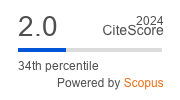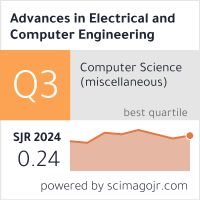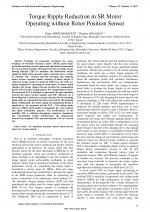| 3/2022 - 6 |
Torque Ripple Reduction in SR Motor Operating without Rotor Position SensorABDELMAKSOUD, H. |
| Extra paper information in |
| Click to see author's profile in |
| Download PDF |
Author keywords
AC machines, machine control, motor drives, observers, torque control
References keywords
torque(26), switched(25), reluctance(25), motor(17), ripple(15), control(12), sharing(9), electronics(9), function(7), electric(7)
Blue keywords are present in both the references section and the paper title.
About this article
Date of Publication: 2022-08-31
Volume 22, Issue 3, Year 2022, On page(s): 53 - 60
ISSN: 1582-7445, e-ISSN: 1844-7600
Digital Object Identifier: 10.4316/AECE.2022.03006
Web of Science Accession Number: 000861021000006
SCOPUS ID: 85137703707
Abstract
Principle of sequential excitation for stator windings of switched reluctance motor (SRM) causes many problems including torque ripples and substantial requirement for rotor position sensing. This paper presents an online torque sharing function (TSF) to minimize the undesirable torque ripples in SRM which operates under sensorless drive system. In classical TSF, variance between incoming and outgoing motor torque responses makes tracking of motor torque to reference torque cannot be achieved. Moreover, the TSFs are mainly designed for operating at rated speed. As motor speed changes, the torque ripples increase because the commutation period (CP) becomes inappropriate for commutation process. The proposed TSF is designed to guarantee the good matching between the motor torque response and TSF reference. So, a linear function is chosen as a torque reference for the incoming phase while an exponential function is selected for the outgoing phase. Additionally, the online tuning of commutation period is employed in the proposed hybrid TSF. The sliding mode observer (SMO) based model is formulated for rotor position and speed estimations purpose. The performance of the modified TSF is validated throughout computer simulations and experimental results. Furthermore, the comparisons between the proposed TSF and conventional TSF are carried out. |
| References | | | Cited By |
Web of Science® Times Cited: 0
View record in Web of Science® [View]
View Related Records® [View]
Updated today
SCOPUS® Times Cited: 1
View record in SCOPUS® [Free preview]
View citations in SCOPUS® [Free preview]
[1] Adaptive Nonlinear States Observer Design of Switched Reluctance Machine, Bouklata, Ali, Barbara, Sara, Benyassi, Mohamed, Oubouaddi, Hafid, Abdelaali, Chaimae, Brouri, Adil, WSEAS TRANSACTIONS ON CIRCUITS AND SYSTEMS, ISSN 2224-266X, Issue , 2025.
Digital Object Identifier: 10.37394/23201.2025.24.12 [CrossRef]
Disclaimer: All information displayed above was retrieved by using remote connections to respective databases. For the best user experience, we update all data by using background processes, and use caches in order to reduce the load on the servers we retrieve the information from. As we have no control on the availability of the database servers and sometimes the Internet connectivity may be affected, we do not guarantee the information is correct or complete. For the most accurate data, please always consult the database sites directly. Some external links require authentication or an institutional subscription.
Web of Science® is a registered trademark of Clarivate Analytics, Scopus® is a registered trademark of Elsevier B.V., other product names, company names, brand names, trademarks and logos are the property of their respective owners.
Faculty of Electrical Engineering and Computer Science
Stefan cel Mare University of Suceava, Romania
All rights reserved: Advances in Electrical and Computer Engineering is a registered trademark of the Stefan cel Mare University of Suceava. No part of this publication may be reproduced, stored in a retrieval system, photocopied, recorded or archived, without the written permission from the Editor. When authors submit their papers for publication, they agree that the copyright for their article be transferred to the Faculty of Electrical Engineering and Computer Science, Stefan cel Mare University of Suceava, Romania, if and only if the articles are accepted for publication. The copyright covers the exclusive rights to reproduce and distribute the article, including reprints and translations.
Permission for other use: The copyright owner's consent does not extend to copying for general distribution, for promotion, for creating new works, or for resale. Specific written permission must be obtained from the Editor for such copying. Direct linking to files hosted on this website is strictly prohibited.
Disclaimer: Whilst every effort is made by the publishers and editorial board to see that no inaccurate or misleading data, opinions or statements appear in this journal, they wish to make it clear that all information and opinions formulated in the articles, as well as linguistic accuracy, are the sole responsibility of the author.



